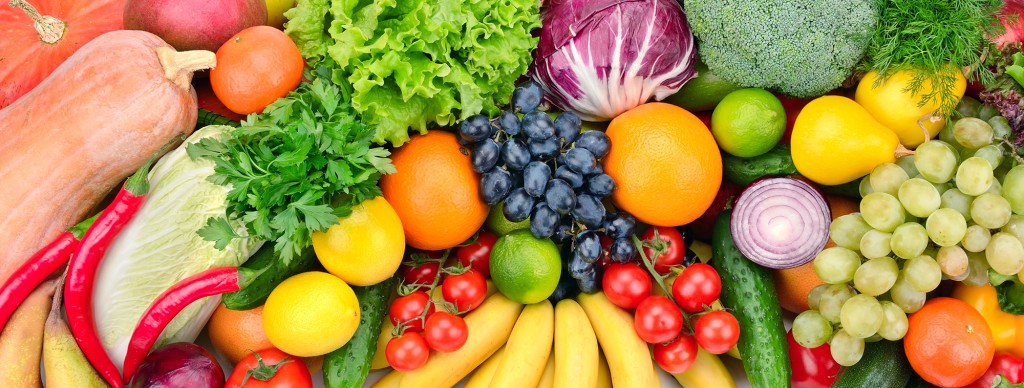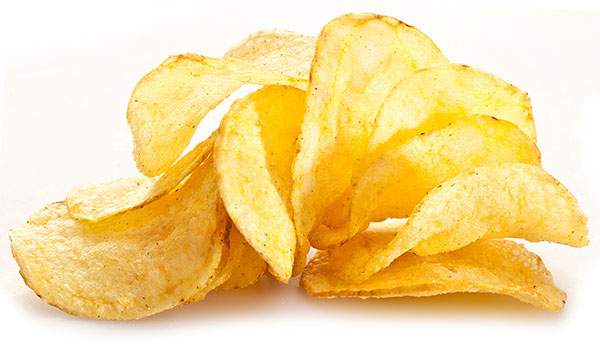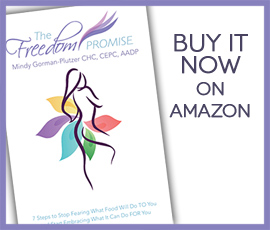A Chapter from the Freedom Promise
Chapter 3
Eat When You’re Hungry, Stop When You’ve Had Enough
 Hunger brought mood swings and food swings. When hungry I had to deal with food choices and the constant reminders of how fearful I was that food would make me fat. It brought the constant reminder of how even the simplest decision to eat made me uncomfortable. On the flip side were the euphoric feelings that came with hunger for it meant I was still in control and hadn’t overeaten. Such madness. I have experienced denying my hunger as a restrictive eater and I have fed emotional hungers with compulsive eating and overeating. When I was restricting, I spent hours counting calories, fat and carbohydrate grams. I was terrified of what food would do to me. I had my own set of rules and conditions for what I would allow myself to eat. I used my relationship with food to control and manage my insecurities and fear of feeling. When I was engaging in compulsive eating behaviors, I ate mindlessly, looking through the pantry for “something” to fill me up, help me check out or take the edge off.
Hunger brought mood swings and food swings. When hungry I had to deal with food choices and the constant reminders of how fearful I was that food would make me fat. It brought the constant reminder of how even the simplest decision to eat made me uncomfortable. On the flip side were the euphoric feelings that came with hunger for it meant I was still in control and hadn’t overeaten. Such madness. I have experienced denying my hunger as a restrictive eater and I have fed emotional hungers with compulsive eating and overeating. When I was restricting, I spent hours counting calories, fat and carbohydrate grams. I was terrified of what food would do to me. I had my own set of rules and conditions for what I would allow myself to eat. I used my relationship with food to control and manage my insecurities and fear of feeling. When I was engaging in compulsive eating behaviors, I ate mindlessly, looking through the pantry for “something” to fill me up, help me check out or take the edge off.
Family birthday celebrations were a great example of this kind of back and forth behavior. The Carvel ice cream cakes were our go-to birthday dessert. I had such a love/hate relationship with that cake. Convinced I would become my own version of “Fudgie the Whale” if I indulged, I would serve the cake to our guests, taking my piece last. I always had a slice lest I be “the MOM” who wouldn’t enjoy a piece of cake on her daughters’ or husband’s birthday. I could have been eating razor blades as I envisioned each mouthful ending up on my thighs. Stressed out over what the cake would due to me, I couldn’t enjoy the deliciousness of it or even focus on the joy that we were celebrating. The irony is that after the party was over and I was alone in the kitchen cleaning up, I would find myself standing, knife in hand, at the cake, slicing slivers of icing and chocolate cookie crunchies into my mouth. I was totally checked out, craving more of what I had mindlessly eaten, ignoring any messages of hunger or fullness.
Understanding true physical hunger, toxic hunger, and emotional hunger is part of the foundation for developing a healthy relationship with food.


Physical Hunger
Let’s look at what happens in our bodies to make us hungry. Our bodies, when left to their devices, are brilliantly efficient. Hunger regulation is a function of fuel in and energy out. A system of brain chemicals signal the body when to eat and when we have enough stored energy, we get the signal to stop. An appetite stimulant called gherelin is released when a part of the brain called the hypothalmus senses that the body is low on energy, i.e. fuel. Along with gherelin, the hormone insulin regulates hunger levels and leptin produces feelings of fullness and satiety to make us stop eating.
For many chronic dieters, hunger becomes just another feeling to ignore. We become so efficient at suppressing hunger that we numb our innate ability to trust or respect this inherent signal as a natural biological process. We have forgotten that food can be a source of pleasure as well as nourishment. We forget that food is foremost a primary source of nourishment, long before we determine it to be pleasure, punishment or even a source of pain.
As newborns the first experiences of love and nurturing occur as we are cuddled and fed. Later on we develop the wonderful associations with food through memories of a beloved grandmother or holiday tradition. These associations can easily translate to unhealthy habits in the way we relate to stress so the association becomes distorted. At some time, we may come home from a bad day and devour bags of cookies or chips. The mind records, feel bad > eat > feel better. The hunger signal is lost and the next time we have a bad day, our minds remember this useful behavior. We have learned to seek temporary pleasure, in order to avoid immediate pain. This temporary pleasure we receive is chemical as the food choices we make when stressed have a direct effect on our mood – the highly refined, high sugar foods create a blood sugar response that is powerful as it creates the sensations of pleasure and relaxation. When the blood sugar response subsides, painful emotion returns, we go back for more soothing and a destructive cycle ensues.
When I refused to give in to my body’s hunger, essentially going hungry all day, ignoring any demand for food and nourishment, I set myself up for episodes of binge eating. I would play a number’s game with myself – how few calories could I eat before dinner? Breakfast was a measured bowl of cereal and skim milk, maybe a few strawberries. Mid-morning I would have some more coffee to keep going and lunch would be a small salad with a fat free dressing or maybe a fat-free yogurt. If I made make it through the afternoon without grabbing something from the pantry, finishing my children’s after school snack, or even munching on that night’s dinner preparations, I would be getting the screaming message of how hungry I was when finally relaxing at the end of the day. Dinner became the largest meal of the day and I usually overate until I was stuffed and uncomfortable. After dinner I would be indulging on the salty, sweet, creamy or crunchy that brought relief from the stress of the day. I would fall asleep uncomfortably full and vow to be better tomorrow.
There is no benefit in not listening to our bodies. We must learn to include them in the conversation because our minds will keep us tied to the toxic beliefs that food will make us fat or that fat and carbs will make us fat but eventually, our bodies will speak up and let us know it needs those nutrients to keep our brains functioning and hormones flowing. Eating when hungry, tuning into our bodies’ signals for nourishment, improves the chances that we won’t end up holding an empty container of ice cream after a day of trying to be “good”.
When we diet in a way that restricts the food that gives us pleasure, or act on the thoughts and beliefs that actually create nutritional deprivation, we are going to crave the foods our bodies truly need for energy and we are going to crave the foods we’ve deemed “illegal”, such as fats and carbohydrates. By not trusting our hunger, we set ourselves up to feel deprived, failures at dieting, and ultimately powerless over food. Identify the craving and listen to it. Hunger tells us it is time to eat and cravings will tell us what to eat.
Eating when hungry and stopping when we have had enough is more about the HOW of eating than the WHAT. The WHAT changes constantly as the field of nutrition science continues to discover and assign new “rules”. The HOW should be constant whether we are eating chicken or enchiladas. It is empowering to choose our food wisely, eat in a slow rhythm so we can enjoy it and get satisfaction, relax into it so we can digest and assimilate the nutrients and become energized as our bodies reap the benefits.

We eat emotionally to look for comfort in emotionally charged situations. Our desire is actually not for the food but for the emotion it creates. It is important to create space between our behavior and the feelings.
We often look to food to distract us from boredom and emotional turmoil.
When my late husband, Stuart, was being treated in the hospital for cancer, I spent many hours alone as he was asleep or semi-conscious from the medicines. I would walk the halls and invariably end up in the cafeteria. Filling up on bitter coffee, salads that were totally unsatisfying, apples that were mealy, stale bagels and sugar-laden yogurts was a way to pass the time. I wasn’t hungry. I was bored, fearful, grieving and lonely. Healthier solutions would have been for me to call a friend, write in my journal or visit the Chapel in an effort to face what I was really feeling.
We sometimes look to food when we really need a hug, a human connection, and to experience security and intimacy. These “cravings” come from another part of ourselves that could be starving for love, connection and fulfillment.
We often turn to food as we celebrate a joyous event like a job promotion with chocolate and champagne. Food is always part of a life cycle event celebrations and often we over-indulge because we aren’t accustomed to allowing ourselves to receive pleasure from food on a daily basis.
There are several differences between emotional hunger and physical hunger. I point this out because very often we don’t know the difference, especially if we have been denying our true hungers for a long time.
Emotional hunger appears suddenly and needs to be satisfied instantly while physical hunger happens gradually and you can wait to eat.
When you are eating to fill an emptiness that is not due to your stomach calling out, you crave a specific food, such as pizza or ice cream. When you eat because you are actually hungry, you are open to options.
When eating in response to emotion or stress, you are likely to eat beyond being full. When eating to satisfy a healthy hunger, you are more likely to stop when you recognize you are satisfied and full.
Toxic Hunger
Toxic hunger refers to the withdrawal symptoms that occur from eating foods with little nutritional value. These symptoms occur when we are experiencing the lower end of the blood sugar curve and they drive our bodies to eat more than we need in response to cravings, leading to weight gain and certainly making weight loss more difficult. If you are reading this book, chances are you have been eating a diet rich in foods that are “light”, fat-free, sugar-free, and essentially fake.
Typical symptoms of toxic hunger are:
- Feelings of emptiness in the stomach
- Gurgling and rumbling in the stomach
- Dizziness, lightheadedness, headache
- Irritability and agitation
- Lack of concentration
- Nausea, shakiness and fatigue
True hunger, as opposed to toxic hunger, signals when our bodies need calories to maintain energy levels and lean body mass. When we eat in response to our body’s wisdom, we won’t become overweight to begin with. In our present toxic food environment, many of us have lost the ability to connect with that wisdom and the signals which tell us how much to eat and what kind of food we really need. The way back from a relationship with food that is mired in toxicity is to examine our beliefs and food patterns, question if they are serving us and make an empowered choice to change.

Sometimes hunger shows up in the form of cravings – and cravings show up in response to extreme hunger.
Cravings are our bodies’ way of signaling that something is missing; a story about an underlying health concern that needs to be addressed or a biochemical and nutritional piece you may be lacking. Often we crave sugar when we really need protein or sleep. Salt cravings may be signs that you need rare minerals like potassium, chromium or copper. You may need to incorporate more mineral rich foods like nuts, seeds and sea vegetables. Chocolate cravings may indicate you need more iron or magnesium; you may need to eat more leafy greens like kale or bok choy.
It may be a bigger than life question that needs a new answer. Are you hearing, “I need chocolate” when it could be spirituality, sensuality, movement, fun or creativity that you are seeking? That piece of cake may mean you desire more sweetness in your life. Truthfully, it is easier to reach for the bag of M&M’s than to dig deep and bypass the comfort level that comes from being in the zone of familiarity. The “cravings” that are triggered by emotional responses are not about food. When we experience a craving, it helps to get curious and ask what is out of balance.
Use the following checklist the next time you have a craving in order to figure out what you are truly “hungry” for:
- When was the last time you ate?
- Did your meal or snack have enough protein, fat or carbohydrate?
- Did you sleep well last night?
- Is there anything physiological going on such as PMS?
- Are you drinking enough water?
- Did something happen in your day to frustrate you?
Do you need to discuss something with your spouse/partner?
Cravings, like hunger, are not signs of weakness. They are valuable and vital messages meant to help you find balance. It all comes down to trusting your body, instead of ignoring and denying what are natural, biological and psychological processes of being.
I am asked this all the time. I believe that there is no such person. We can be healthy eaters, those who have a healthy relationship with food as opposed to people who only eat healthy food.
Some eat 3 meals a day and others eat 4-6 smaller meals. Some can skip a meal when busy or be that picky restaurant diner who needs to make sure her menu selection is prepared as she wishes.
Some are extremely conscious of nutrition while others just eat what is available. Some may overeat on special occasions and others rarely overeat because food just doesn’t matter that much. Some prepare elaborate meals for family and friends and others have the local take-out places on speed dial. What all healthy eaters have in common is the following:
- They eat when they are hungry or have a craving.
- They choose foods that will satisfy them.
- They eat with awareness and stay connected to their bodies.
- They stop eating when they are full or satisfied.
I made reference earlier to the fact that HOW we eat is as important as WHAT we eat. Having a healthy relationship with food means we are not defined by HOW much, HOW little or HOW often we eat. Healthy eaters recognize and respond appropriately to their hunger.
Respecting their hunger, listening to what it’s asking for, and including their bodies in the conversation allows them to choose satisfying food. Healthy eaters don’t choose based on the calculation of fat and calories. They don’t wait until they are starving or eat if they aren’t hungry. They make their own menu selections, not what the person across the table orders.
The good news is that we can relearn to tune into our body’s wisdom and develop a healthier relationship with food as we begin to trust our hungers and in turn trust our bodies.
When we are satisfied, we can stop when we’ve had enough. Feeling full and feeling satisfied are separate but related reactions to hunger and the experience of eating. When we lose touch with our body’s needs it is hard to know when it’s had enough of anything, especially food.
Sometimes the distortion stems from a childhood message of finishing all that is on our plates because we were plied with stories about children starving in China, or that our mothers slaved for hours over a hot stove. Maybe your parents grew up during the Great Depression so you were taught to clean your plate quickly since food could easily be scarce. What happened was that as children we weren’t allowed to respond and react to our body’s signals for fullness and satiety. We grew into adults who are unable to recognize such signals or willfully ignore them. We learned to base our sense of enough on external cues – portion size, whatever we can get away with, what we feel we deserve, media messages, or even the approval of those with whom we are eating.
Maybe you felt you needed to be a certain weight or size in order to be accepted into the sorority of your dreams; maybe the messages you received growing up were that no one would love you if you weren’t thin enough; maybe your spouse or partner has indicated that he’s not attracted to people who are overweight; maybe your extra weight is offering you protection from being seen and heard; maybe you have dieted yourself down to a weight so you can feel either invisible or powerful. In an effort to seek safety, love and belonging, we often manipulate our food intake so that we can get what we want.
By not honoring our hungers in an authentic way, we lose sight of the bigger picture – that what we are seeking is nourishment that reflects how we want to experience life.
The first step towards developing a healthy relationship with food is to give ourselves permission to eat anything. This may sound counter productive but when we take the moral dilemma away from our meal planning and snack choices we rid ourselves of the shame and guilt that results from depending on willpower alone. The next step is to rely on hunger and fullness cues. The third step is to eat for physical rather than emotional or stress related reasons. Making decisions about when and what to eat based on what our body is experiencing creates a sense of empowerment. Empowerment comes from asking ourselves if the food we are choosing to eat will truly satisfy and sustain us. It is empowering to be accountable to the experience we want from the meal. For example, if you were hungry for lunch and chose to drink a smoothie, will it hold you until your next meal? Would just a salad do the trick or would you enjoy some chicken with that? This practice should also be extended to food that is ordinarily on our “should not eat” list. If you have a sweet tooth, will strawberries satisfy?
Because it’s been said that how we do one thing is how we do everything, your relationship with food will mirror how you work, relate to people and how you take care of yourself. Not knowing when we have had enough can mean we don’t know how to effectively use the words yes and no and it becomes most obvious in the area of food issues. Our restrictive eater says no too often, our compulsive, emotional eater says yes too often. The goal is to strike a healthy balance. There can be great discomfort in learning to say no and yes to ourselves and to others. Developing that muscle will introduce you to the concept of integrity to self, inspiring and motivating you to move closer to the loving, joyful and healthy life you deserve and desire.

- When you want to eat and you are not hungry, ask yourself, “What is it I really want?” Acknowledge that you may want to be with someone and you are alone, or maybe you are with someone and want to be alone. Practice being present, experience what is happening within you, when you can be out of your head, separate from your thoughts. If it can be satisfied with something other than food, it is not hunger.
- Remember that hunger is a survival mechanism. Even if you have checked out from allowing yourself to feel physical hunger, know it is there. Before you eat, rate your hunger by creating an intuitive inner scale from 1-5. 1 is noticing hunger and 5 is starving. Plan to eat when you are at a 2-3. Food tastes best when you are moderately hungry.
- Recognize when you have had enough – create a fullness scale from 1-5. Stop when you are at a 3-4, nourished and energized, satisfied but not stuffed. At that point, push your plate away or, if you can, leave the table (you don’t want to abandon your dinner companions). If you are out, ask the server to remove your plate.
What would it be like for you if you ate only when you were physically hungry?
I happily nourish my body and receive full satisfaction for moderate meals daily.
I listen to my body and eat only when I am hungry, staying in control of what and when I eat.
I am starting to realize food is not the answer to my problems.
I need not rely on willpower as I am becoming empowered to transform into someone who is responsible with food.
I successfully release the need for food that makes me uncomfortable as I release the desire to eat beyond the point of being full.
Read More About It
When Food Is Love, Geneen Roth
Intuitive Eating, Evelyn Tribole
Nourishing Wisdom, Marc David

